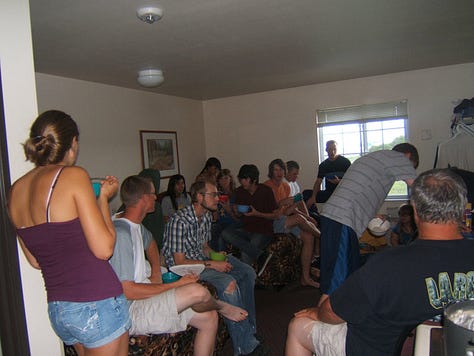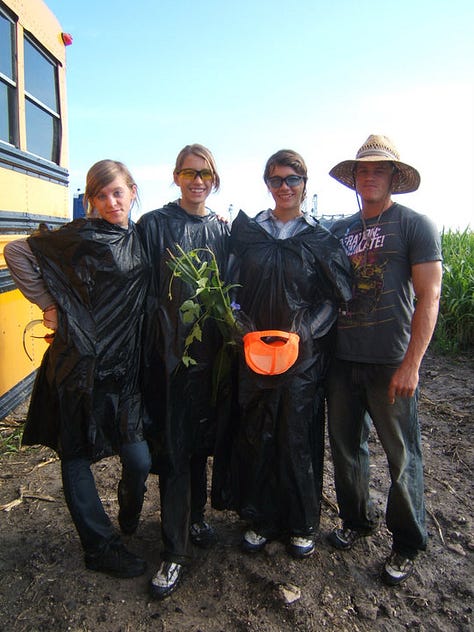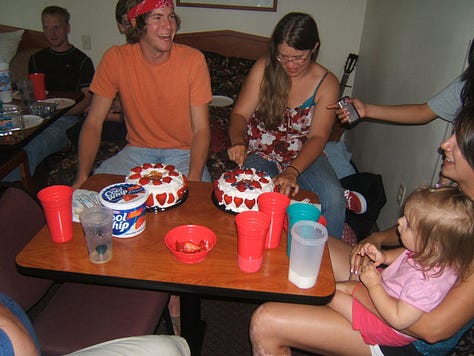29 June 2025
Dear Jana,
From high school through college, I spent summers detasseling in Iowa cornfields.
My dad, who was a city schoolteacher the rest of the year, would drive back home to the farm every June to run detasseling crews. He would recruit teenagers from schools and churches to come work a summer job that was brutal but character-building, intense but short-lived. Detasseling could fit between sports camp and family vacation more easily than bagging groceries, and you got tougher and tanner besides. Agricultural work is strictly dependent on the weather. When the corn tassels, millions of acres of cornfields will pollinate without regard to man-made holidays or, say, July 17th birthdays. Other scientists may be able to set their own hours in a climate-controlled lab, but farmers have to milk the cows on Sunday, and detasselers are in the fields dawn til dusk up to seven days a week during detasseling season.
Let me back up a tad and explain the corn business. You’re likely familiar with popcorn, sweet corn1, and field corn (which goes into cornflakes and cattlefeed). Field corn is the money-maker, but it’s been bred for eating qualities, not self-perpetuating qualities. To grow a good crop you need good seed. Seed that has been cross-bred to resist pests and plagues and drought and flood and grow 12’ tall with consistently large full fruit. Only a small percentage of corn is seed corn, and only seed corn is detasseled. Why do we remove the tassels (de-tassel)? Keep on reading.
Corn is a type of grass. A corn stalk is like a single giant blade of grass that grows one large ear or two smaller ears of “corn on the cob.” Corn plants are self-pollinating. The “female” tuft of silk grows out of the side between the leaf-sheaves, and the “male” tassel on top flowers to dust pollen on everything below when a breeze blows by. Each silk-strand that catches a mote of pollen will form a single kernel on an ear of corn. In seed corn fields, two breeds of corn are planted side by side, and one of those breeds is detasseled, so that it will not pollinate itself, but rather be pollinated by the tassels of the other breed. Machines called cutters and rollers detassel the seed corn fields first to remove most of the tassels, but only human beings are equipped to clean out every single tassel that gets missed. Ag engineers at seed corn companies want to produce a high efficiency crop. I say high efficiency, which is what the salesfolks probably mean when they say high quality, but the difference is worth considering, especially if you’re Wendell Berry.
My dad’s goals were to feed his family and motivate America’s youth. His strengths of talking, debating, and coaching aided these pursuits. As his own children aged up, we became his crewleaders, although I, being the oldest and least athletic, leaned into the role of timekeeper and bookkeeping assistant as much as possible. But after the initial paperwork was filed, I too loaded onto the bus before sunrise to walk muggy miles through rows of corn. I hefted a roguing spade and pulled tassels until my arms ached, same as the rest of my siblings and cousins and friends. I poked holes in a new garbage-bag poncho every season, lugged thickly caked legs through the slick mud trenches, changed soggy socks out for dry at 9 AM lunchbreak, treated sunburn and blisters and bug bites and corn rash and heat rash and corn leaf papercuts, and then loaded back into the sweat-stench of an unairconditioned bus stuffed with junior high boys to rumble and lurch back to the Value Inn. On the edge of the parking lot we scraped as much crusted dirt off our boots and jeans as we could and wrung out our socks and bandanas and blissfully, mercifully sat as we awaited our turn to shower. A load of laundry and grocery run later, we slapped together a couple loaves of PB&J and sank into bed before the cycle began all over again at 4 AM.
For those fleeting and paradoxically interminable summers, we scoured the rows of corn during our waking hours and dreamed of tassels all night, as though detasseling was a video game we’d played far too long. Our bodies memorized the sun’s arc and earth’s furrow. We walked in song and silence, in sun and rain. Miles each day. Muscles sore. Skin burned and blistered and soaked and sweaty. Food never tasted so good. Sleep never felt so sweet. Jokes never sounded so funny. When I meet someone else who’s detasseled, we exchange a knowing glance, an instant bond.
Brett asked me to marry him during detasseling season. In a motel parking lot surrounded by cornfields, right before the fireflies came out, he pulled a deck of cards and a diamond ring out of his pocket. Our daughter was nearly born in the middle of a cornfield. But I confess, what I like most about detasseling is writing about the memory—from a good long distance down the road.



We Iowans love our sweet corn tender, plump, and juicy in late July or early August. The best yellow-and-white-kernel varieties we call “milk and honey” or “peaches and cream.” We spit over-mature corn out of our mouths. We shuck it, straight out of the garden, under the driveway basketball hoop, by the five-gallon-bucketfull. We steam it in a stockpot with an inch or two of water at the bottom. We slather it in butter, salt, and pepper. The slops go to the hoghouse or henhouse, where everybeast joins the feast.





This was fascinating and uncharted territory for me as a reader. Thank you for this gift, Reagan.
Reagan! Oh my goodness... The timing of this just makes me smile. Steve and I are on our way home from TN with 3 grandchildren buckled in the back seat. Yesterday we went to the farmers market and I bought 1 handwoven basket from an Amish lady (I wanted ALL of them!), black eyed peas, peaches, and a bag of peaches and cream corn! Right. Off. The. Truck. We cooked the corn within about 2 hours and had it for lunch. Have I ever tasted corn that amazing in my 61 years? No I have not. Did I eat 3 cobs? Oh yes I did and it was the best thing ever.